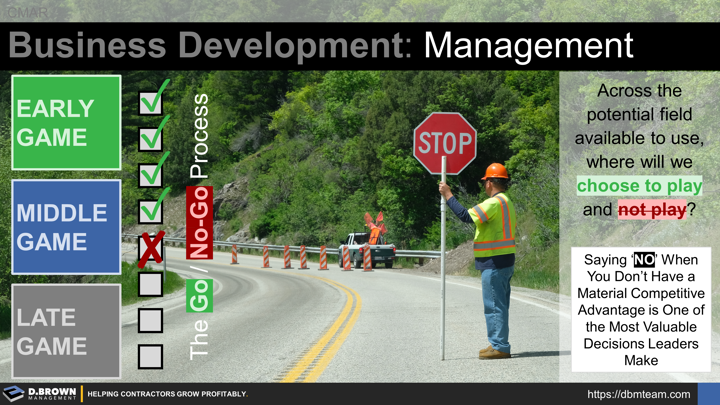Across the potential field available to use, where will we choose to play, and not play?
- This is the first of five interlinked questions that define your strategy including your market choices.
- Sustainable growth comes from the consistent execution of those choices.
- This starts with the four truths around business development and effectively playing the early, middle, and late game.
The function of business development for a contractor is to bring relationships and project opportunities to the table that are reasonably aligned with your strategic market choices.
Senior management's responsibility is to determine whether that project opportunity or relationship should be pursued further and how. This is the Opportunity Go/No-Go process and part of the sales funnel. It may have several gating steps to it which determine progressively larger investment of the contractor's finite resources in pursuing a project or relationship. The process will grow in both complexity and effectiveness as a contractor successfully navigates different stages of their own growth.
A Go/No-Go process will involve a range of people and some tools that help prioritize opportunities and relationships against two critical dimensions first:
- Alignment with your strategic choices around market sectors, geographies, customers, project types, delivery methods, scopes, etc.
- Alignment with your operational capabilities and capacity in the timeframe required including estimating, preconstruction, engineering, project management, field management, key trade partners, etc.
Ideally, if your strategic market choices are good and your business development function is effective, you should have an abundance of opportunities that are in the upper-right quadrant of this opportunity evaluation.
This abundance means that you can further choose which opportunities to pursue based on your competitive advantages and the probable returns (profit) for the risks you are taking. A good place to start developing this part of your Opportunity Go / No-Go process is with questions around the 8 major factors typically used by project owners to evaluate RFP (Request for Proposal) responses.
Of course, some of your weighting and scales will be different - for example, you will be looking for project opportunities where you can get a higher fee and where you can spend appropriately on your general conditions to both mitigate risks and develop people.
An experienced but unbiased 3rd part can be invaluable when it comes to developing then consistently using an Opportunity Go / No-Go process. Remember that this process must evolve with each stage of growth, especially as the Founder/Owner becomes progressively more distant from the process.
All relationships begin with a simple conversation.

